#it's set in 2003 new york about a guy in the mafia who takes on jobs to earn money for the sake of money
Text
I'm honestly not sure why Kishimoto Masashi hasn't done any other stories that isn't Naruto (well, there's Samurai 8, but that ended up cancelled, and Boruto is...well. It's Boruto But Let's Disassemble Boruto's Dad's Canon Until Not Even The Atoms Are Left).
Compared to the high fantasy ninja-cum-borderline-modern-day-cyberpunk aesthetic, Mario was such a breath of fresh air. Maybe not as lived in as Naruto (because it's a forty-four page one-shot, and you can't really afford to waste time on making New York feel "lived in" in that many pages), but it's so grounded in reality that the environment and the foundations of the story are already set in place. It doesn't have to worry about playing with the Magic System or keeping its chronology from getting tangled up in retcons and deus ex machina. It's short, it's simple, and gets right to the point while leaving many of its other elements inferred and in the background.
#as i understand it. or at least it's speculated. that elements of samurai 8 are being carried over to boruto#hence why it's moved away so quickly from naruto's 90s tech to an almost postmodern cyberpunk era#as well as teenage punk and grunge aesthetic that can almost be called dystopian#it's why - for me - boruto has felt less 'ninja fantasy' and more 'urban fantasy but throw in space-faring alien leeches into the mix'#especially with the arrival of two blue vortex#but the problem with the otsutsuki is how utterly last minute they are in canon#w/ no buildup whatsoever#and its timeline is such a mess that a plate of spaghetti looks more coherent#mario doesn't have that problem#it's set in 2003 new york about a guy in the mafia who takes on jobs to earn money for the sake of money#who eventually teams up with a female hitman in order to earn his own territory#there's mention of his late yakuza mother and how the hitman he's working w/ looks like her#as well as his necklace in the shape of the libra's scales that play into his ties between his mother & his partner#BOOM it doesn't waste ANY time faffing around. the plot just gets right to it#it's an interesting little oneshot that unfortunately doesn't really leave room for continuation#due to the way the ending doles out his fate#like. kishimoto has the POTENTIAL for constructing tight storycrafting#we saw this in the minato one-shot recently#he just needs to do what HE wants to do and not try to aim high#a'la try to make it another naruto/boruto#armi reads manga#manga
5 notes
·
View notes
Text
Movie Review: The Irishman
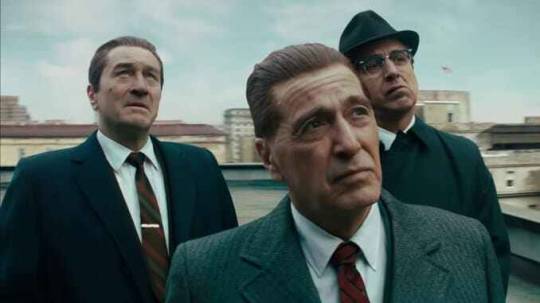
One of the reliable story beats of Martin Scorsese’s mob movies is that loudmouths don’t last long. The heroes, as it were, of these films are hitmen, fixers and soldiers who nonetheless behave as if they were just going into their 9-to-5 job at the local water plant. In the case of his latest film, the unassuming day-to-day hack is Frank Sheeran, who recounts his mob days from a wheelchair in an old folk’s home, and the loudmouth who doesn’t know what’s good for him is none other than Jimmy Hoffa. Hoffa’s fabled end takes up a tiny portion of the film, which is more about Frank and how completely mundane his life is when he isn’t shooting people in the head.
Chronologically speaking, we first meet Frank, played by a de-aged Robert De Niro, as an ordinary truck driver who, in need of extra cash, offers to secure the good beef for a small-time mob player (Bobby Cannavale). Frank does the penny-ante job of stealing meat until he steals so much someone’s gonna notice. He’s gotten off the hook by Bill Bufalino (Ray Romano), a lawyer for the union, which in this case means he’s also a lawyer for the mafia. Bufalino is impressed by Frank’s unwillingness to name names rather than go to jail, and introduces him to his cousin Russell (Joe Pesci). If you’re good at what you do, you hope to get promoted, and Frank gets promoted indeed, from small-time theft to everything from racketeering to murder. Soon he’s put in front of Hoffa himself, played by Al Pacino.
The movie flashes back and forth between Sheeran’s earlier days in the mob and a road trip he and Bufalino are taking, which we find out or realize is intended to end in Hoffa’s death. The structure is rather ingenious: the bulk of the movie concerns the burgeoning friendship between the two men, and so each return to the fatal drive feels like it is drawing us on to an end we don’t want to see.
This has always been Scorsese’s gift to the crime genre: that he can make us watch terrible men for hours and feel for them. De Niro is the all-American working stiff whose work just so happens to be killing other mobsters; De Niro plays him as a straight-forward, matter-of-fact kind of guy, the type who knows exactly what line of work he’s in but doesn’t make a lot of hay about it. De-aged or not, it’s the kind of role De Niro has always excelled in; he’s never been good as a flashy actor. Pacino’s Hoffa is the opposite kind of man. He’s fiery, passionate, quick to anger, and neither running a union nor being in the mob is just a job to him: he’s firmly attached to both and will do a hell of a lot to get his way. Pacino gets to turn on the drama so De Niro does not have to, and the rapport works. Pacino has had an interesting career, with a few really big hits followed by the better part of a couple decades in utterly forgettable stuff, but this role reminds us why he’s famous to begin with.
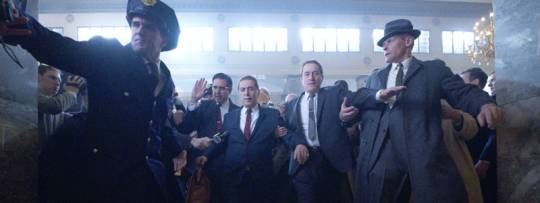
The runtime may seem, to audiences not accustomed to the long character dramas Hollywood used to make, like an obstacle, but the time is valuable: it establishes everyone, but especially Sheeran and Hoffa, as real people, giving their fates the air of Greek tragedy. There is a scene in which Hoffa angrily berates a roomful of his subordinates, and Frank gets offended and leaves. One of the most powerful mob men in the world interrupts the meeting to chase after him and apologize. This, at least if Sheeran’s account is to be believed, is real friendship, and Scorsese and screenwriter Steven Zaillian (Gangs of New York) put the seemingly daunting 209-minute runtime to good use by firmly establishing it, building up the tension and making the inevitable end a real wrench.
Other ways the time is used is by Scorsese and Zaillian letting characters have the space to simply have conversations that don’t advance the plot. There is a conversation with a man who is insecure about the size of his ears. There is a nearly ten-minute debate about how long it is appropriate to wait for someone if they are late to a meeting. In writing, this sounds boring, but like the conversation about socks from Clint Eastwood’s Million-Dollar Baby, what they are doing is drawing us into the way real people who know each other talk, instead of just rushing forward to the next plot point. Similarly handled are scenes of mob guys doing mob stuff. Frank patiently sets up an explosion at a rival laundromat, but we only see the set-up, and hear about the bombing. An attempt to ruin a taxicab business consists of men pushing the cars into a river while bemoaning how much hard work it is. Flash and dazzle is easy, but this is arguably more interesting.
There are times when Scorsese could have stood to compact things a little bit, most notably in the number of characters we’re fleetingly introduced to. Every time a true-to-life mobster shows up on screen, the movie informs us briefly who they are and how they eventually died, and Frank, Jimmy and Russell meet with so many of these people, many of whom have one or two scenes, that Scorsese would have been fine going with a couple composite characters; the heart of the film is Frank and Hoffa, and the best stuff focuses on that relationship. If you have no idea who Hoffa was except that he disappeared, the film still works on that level.
The last act of the film does something Scorsese’s previous mob films have only hinted at: focuses on the end of Frank’s life. Sheeran died in 2003, and his claims to have been Hoffa’s killer have been disputed, but true or not, watching this once-powerful man decay and simply die, slowly and unglamorously, of old age and boredom is a double-edged sword: De Niro makes us feel the weight of his own mortality, while at the same time it is hard to sympathize with a man who, however ordinary he seemed, lived his life in blood. Scorsese, as his custom, does not tell us what to think of Frank. He just places him before us, and lets us decide. The Irishman is treading mostly familiar ground for the director, but in a way that draws us into this world and these people arguably better than any of his previous efforts.
Verdict: Highly Recommended
Note: I don’t use stars, but here are my possible verdicts.
Must-See
Highly Recommended
Recommended
Average
Not Recommended
Avoid like the Plague
You can follow Ryan's reviews on Facebook here:
https://www.facebook.com/ryanmeftmovies/
Or his tweets here:
https://twitter.com/RyanmEft
All images are property of the people what own the movie.
3 notes
·
View notes
Text
In Modern Animation, Baccano! Tales of Power and Machiavellian Principles
While writing about the movie, The Godfather, and thinking about Machiavelli, I was reminded of a very close example I could talk about that takes a lot of elements of both The Godfather and from Machiavellian principles. This is my favorite animated show, or anime, Baccano!.
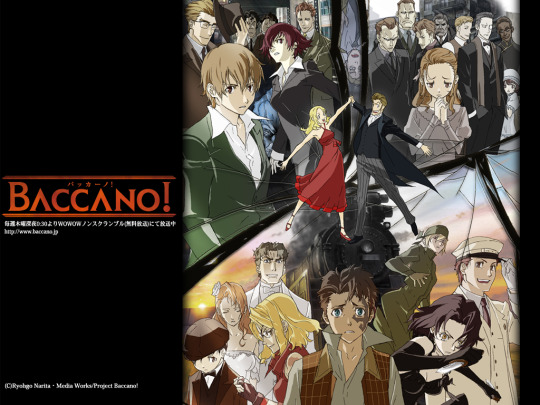
(An artwork depicting some of the characters from the three different simultaneous storylines that are displayed within the show.)
This animated series originated as a series of light novels in 2003 under the same name, written by Ryohgo Narita. Light novels, are short Japanese novels that usually contain a few illustrations in them. The first few light novels were made into an anime in 2008 by the studio Brain’s Base. The series has also been dubbed for the US by Funimation. (Who did an amazing job with the dub in my opinion, and is just as good or better than the original Japanese cast.) The title: Baccano! is Italian, and translates to “turmoil” or “ruckus” which is a very fitting name once you get into it. To summarize the series up, (this in now way does the show justice at all btw), the story revolves mostly around three storylines, all taking place at different times, yet are presented together in the show alongside each other. Each storyline intertwines with the other through the characters. Throw characters with immortality into the mix and you get absolute craziness, or turmoil, as the name suggests. Well that’s all very confusing, but I promise that it all works together quite well, better than I thought something like this ever could. The non-linear way of storytelling is off-putting at first, but I quite like the unique style it has, and it gets easier to understand with each re-watching. If anything, I recommend the series for its masterful dynamic of characters and storytelling in a way that most stories would frown upon. Just the opening animation sequence introduces most of the important characters and makes me excited to watch what each of them will get up to in each episode. (Also, that jazz! The sountrack is absolutely godly.)
youtube
The series reminds me of The Godfather, in that part of it is set in 1920’s prohibition America, (New York specifically), and that a good portion of the story revolves around the mafia and another similar crime group, the cammora. This series is probably one of the most well known depictions of the cammora crime group in popular culture. Anyway, the animation itself is flawless at depicting the fights and displays of violence associated with mafia crime groups.



Here’s just some of the fun ones. (In which I realized that Firo (the guy in green) is the one beating up guys in each gif. He certainly has a knack to get himself in situtations.) By the way, the anime itself is quite violent, so I wouldn’t recommend it to the faint of heart.
As in The Godfather, the crime families in Baccano! must keep their power and influence, often times through violence. As this is prohibition era America, the way they make their living is through the illegal trade of alcohol. (Unlike The Godfather and the trade of drugs.) The law of the underground is very Machiavellian and ruthless.
By far the most Machiavellian character in the entire show would be Vino/Claire Stanfield or as he is most commonly known, The Rail Tracer.

This itself is a bit of a spoiler, but I have to spoil it in order to explain. In the opening sequence around 0:50, when the liquor bottle is dropped into the hands of the conductor, is the subtle and really well done introduction of Claire in the opening, marking him as an important character, without spoiling his identity. (Just one of the masterful decisions that make this anime my favorite.) Anyway, the Rail Tracer is introduced in the show as a myth of a terrifying monster that hunts down trains and makes the people on them disappear. (From the The Grand Punk Railroad, 1931 segments of the show). It is later revealed that one of the conductors (initially introduced as just “the young conductor” in the earlier episodes), is the legendary assassin, Vino (the italian word for wine: named this because of the way he kills his enemies… ruthlessly and quite messily). He is also the background to the “Rail Tracer” myth. Intelligent, crafty, and very dangerous, this character is a favorite of mine, because of his complex simplicity. What he believes is that he is basically the God of the world (solipsism) and that he can’t die, because if he did, the world would cease to exist. Therefore, his tactics and way of killing (his way of keeping power), are simply, in his mind, the way to preserve the world as it is. What makes him Machiavellian at his core are his morals. As it is revealed later by another character, even though he is an assassin, that he has a clear set of morals that he abides by, mercy towards certain people being one of them. The scene where he explains his philosophy (also listen to how amazing a job the voice actors did):
youtube
“So what if I’d spare him, to my mind it’s the certainty in myself that I possess which allows me to have that kind of mercy or compassion... So remember this, mercy and compassion are virtues that only the strong are privileged to possess, and I, am strong.” To me this little quote just screams Machiavelli. Also this guy is just so sure of himself and charismatic, it’s hard not to find some respect for him somewhere, which all in all just makes him an even more Machiavellian character.
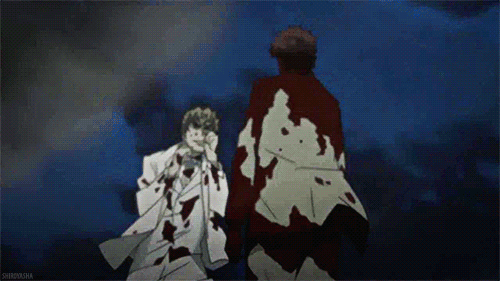

I mean, come on, just look at the guy. He has all the makings of a Machiavellian prince in my book. On top of that, even though he’s some crazy assassin, he still manages to come off as human, which is extraordinary characterization in my opinion.
youtube
My absolute favorite character from the series would be Chane Laforet, who comes with a tragic backstory of her own.

I’ll be brief on this, but her father manipulated her into believing and following his every word, which is pretty ruthless and Machiavellian in itself.
Lastly, i just want to say that the soundtrack for this anime is amazing and highly worth checking out if you like jazz and swing style music. Some favorites of mine:
youtube
This song really embodies the whirlwind like atmosphere of the entire show. Plays during a lot of the fight scenes and just scenes of general craziness.
youtube
This song is definitely one of my favorites. It manages to sound sad, serene, and then later unnerving and urgent, all while maintaining motifs of the main theme throughout. It also helps that it’s basically the theme of both Chane and Claire, my two favorite characters.
https://youtu.be/tDJ30O81d70
Lastly is this song (Tumblr won’t let me post more than 5 videos straight to my post), conveys a serene feeling and a satisfaction along with it. It plays in the last episode, really bringing the show together and closing it off well while still leaving it open-ended. Really good end to a great series.
It’s really violent and not for everyone, but I would highly recommend it, and I encourage everyone to check it out, it’s really a masterpiece.
21 notes
·
View notes
Photo
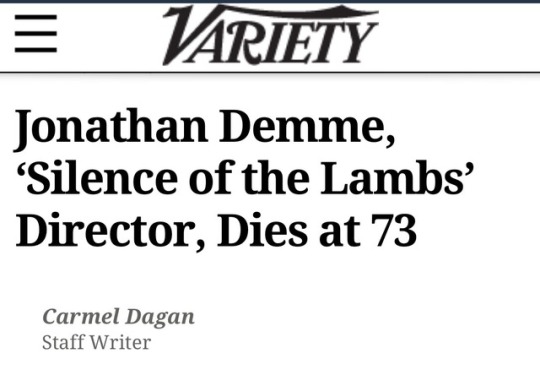
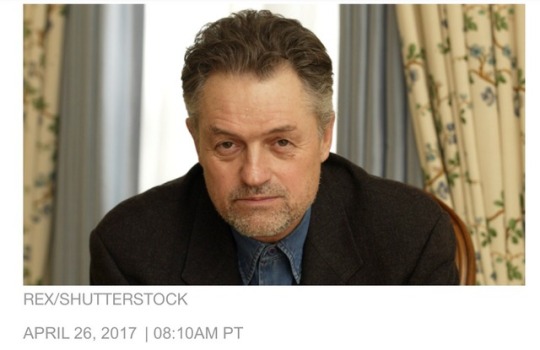
Oscar-winning director Jonathan Demme has died of esophageal cancer and complications from heart disease, according to published reports. He was 73 years old.
Demme is best known for directing “The Silence of the Lambs,” the 1991 horror-thriller that was a box office smash and a critical triumph. The story of an FBI analyst (Jodie Foster) who uses a charismatic serial killer (Anthony Hopkins) to track a murderer became only the third film in history to win Academy Awards in all the top five categories ( picture, actor, actress, director, and adapted screenplay), joining the ranks of “It Happened One Night” and “One Flew Over the Cuckoo’s Nest.”
Though he had his greatest success terrifying audiences, most of Demme’s work was looser and quirkier. He showed a great humanism and empathy for outsiders in the likes of “Melvin and Howard,” the story of a service station owner who claimed to have been a beneficiary of Howard Hughes, and “Something Wild,” a screwball comedy about a banker whose life is turned upside down. He also scored with “Married to the Mob” and oversaw “Stop Making Sense,” a documentary about the Talking Heads that is considered to be one of the great concert films.
Following “The Silence of the Lambs,” Demme used his clout to make “Philadelphia,” one of the first major studio films to tackle the AIDS crisis and a movie that won Tom Hanks his first Oscar for playing a gay lawyer.
The director most recently made 2015’s “Ricki and the Flash,” starring Meryl Streep as an aging rocker who must return home to Indiana due to a family crisis.
He was nominated for an Independent Spirit Award for directing “Swimming to Cambodia” in 1988, and his 2009 feature “Rachel Getting Married” drew Indie Spirit nominations for best feature and director.
Demme won the International Documentary Association’s Pare Lorentz Award in 1997 for his film “Mandela,” and his docu “Jimmy Carter Man From Plains” picked up the Fipresci Award at the Venice Film Festival in 2007. He made two documentaries about Haiti, 1988’s “Haiti Dreams of Democracy” and 2003’s critically acclaimed “The Agronomist.” Of the latter the New York Times said, “The turbulence that led to the removal of Jean-Bertrand Aristide from Haiti’s presidency gives ‘The Agronomist,’ a superb new documentary by Jonathan Demme, a melancholy timeliness. Its hero, Jean Dominique, embodies the fragile, perpetual hope that Haiti might someday nurture a just and decent political order.” Another standout documentary was 1992’s “Cousin Bobby,” about Demme’s cousin, an Episcopalian priest in Harlem.
In addition to “Stop Making Sense,” Demme did documentaries on the Pretenders, Bruce Springsteen and Neil Young, and he also directed quite a number of music videos, drawing a Grammy nomination in 1987 for best long form music video for “Sun City: Artists United Against Apartheid.”
After the enormous success of “The Silence of the Lambs” (ranked No. 23 on IMDb’s Top 250 movies; worldwide gross $273 million), Demme returned a couple times to the conventional Hollywood thriller genre with 2002’s lighthearted “Charade” remake “The Truth About Charlie,” which starred Mark Wahlberg and Thandie Newton and proved a disservice to the classic Stanley Donen original, and 2004’s big-budget, high-profile remake of “The Manchurian Candidate,” starring Denzel Washington, Liev Schreiber and Meryl Streep, which just about broke even but had its fans among those who had not seen John Frankenheimer’s classic original.
Demme’s very conventional 1993 film “Philadelphia,” starring Tom Hanks and Denzel Washington, brought the subject of AIDS to the attention of Americans previously uninterested or biased against the disease’s perceived victims. Hanks starred as a man with AIDS wrongfully fired because of his condition, and Washington played his lawyer. The film won Oscars for Hanks’ noble, courageous performance and for Bruce Springsteen’s song “Streets of Philadelphia,” and Ron Nyswaner’s script was Oscar nominated. His 1998 adaptation of Toni Morrison novel “Beloved” starred Danny Glover and Oprah Winfrey.
Demme came to the attention of Hollywood with the 1980 film “Melvin and Howard,” in which Jason Robards starred as a bearded, bedraggled Howard Hughes encountered by struggling Everyman Melvin Dumont, who helps Howard out — only to be left $156 million in a Hughes will of dubious authenticity. The film worked because it was not about Hughes but about Dumont, played by Paul Le Mat (one of Demme’s favorite actors). Roger Ebert said: “Dummar is the kind of guy who thinks they oughta make a movie out of his life. This time, he was right.” The film drew three Oscar nominations, winning for best supporting actress (Mary Steenburgen) and original screenplay (Bo Goldman), while Robards also drew a nomination.
The 1984 film “Swing Shift,” a romantic dramedy set on the homefront during WWII and starring Goldie Hawn and Kurt Russell, was directed by Demme but taken out of his hands by the studio and recut, reportedly to make Hawn’s characterization more flattering.
The same year, however, he also directed Talking Heads concert film “Stop Making Sense.” Reviewing it when it was re-released in 1999, the San Francisco Chronicle wrote of the “tingle of satisfaction” that comes “when a piece of entertainment is so infectious, so original and so correct in its judgments that a viewer can sink into his seat — secure in the knowledge that you’re in good hands. Has there ever been a live concert film as vibrant or as brilliantly realized?”
In 1986 Demme perfectly paired Jeff Daniels and Melanie Griffiths in the offbeat, New Wave-flavored indie comedy “Something Wild” and drew an erotically anarchical performance from Griffiths — she quickly convinces Daniels’ ordinary business guy that she’s capable of anything. The first hour of the film is, as Roger Ebert suggested, “filled with such a headlong erotic charge that it’s hard to see how he can sustain it” — and Demme couldn’t, but even the second half wasn’t bad. The film featured an impressive debut from Ray Liotta as Griffiths’ lunatic ex-boyfriend as well as performances by John Waters, John Sayles and cult band the Feelies.
Film Quarterly declared in 1987 that Demme’s career in the 1980s “represents the interesting case of an American director experimenting with film-making at once trendy and radical.” This was exemplified by both “Stop Making Sense” and “Something Wild.”
Demme next shot brilliant monologuist Spalding Gray’s “Swimming to Cambodia” for the screen, with excellent results all around. The Austin Chronicle said, “Laurie Anderson’s tribal score and Demme’s perfectly executed direction take us right inside the mind of this eccentric genius.”
The director’s 1988 comedy “Married to the Mob,” starring Michelle Pfeiffer and Alec Baldwin, with excellent supporting performances by Dean Stockwell as the Mafia boss and Mercedes Ruehl as his far fiercer wife, was a critical and popular success. The New York Times said: “Jonathan Demme is the American cinema’s king of amusing artifacts: blinding bric-a-brac, the junkiest of jewelry, costumes so frightening they take your breath away. Mr. Demme may joke, but he’s also capable of suggesting that the very fabric of American life may be woven of such things, and that it takes a merry and adventurous spirit to make the most of them. In addition, Mr. Demme has an unusually fine ear for musical novelty, and the sounds that waft through his films heighten the visual impression of pure, freewheeling vitality. If making these films is half as much fun as watching them, Mr. Demme must be a happy man.”
The 2008 film “Rachel Getting Married,” which bore some similarities to Noah Baumbach’s 2007 effort “Margot at the Wedding,” starring Nicole Kidman, while prefiguring Demme’s own “Ricki and the Flash,” provided an excellent vehicle for Anne Hathaway to demonstrate acting ability in a largely unsympathetic but intriguing role of a young woman, out of rehab long enough to attend the wedding of the sister she’s jealous of. It was also a celebration of multiculturalism, which struck some critics as didactic or politically correct.
Demme directed an adaptation of the Ibsen play “The Master Builder,” penned by and starring Wallace Shawn, in 2013. In 2015, in addition to “Ricki and the Flash,” he directed the docu-series “The New Yorker Presents,” bringing to life the iconic magazine.
Robert Jonathan Demme was born in Baldwin, Long Island, New York, and attended the University of Florida. Like John Sayles, he began his directing career in Roger Corman’s stable, helming women’s prison exploitation film “Caged Heat” in 1974; nostalgic road trip film “Crazy Mama,” starring Cloris Leachman, in 1975; and Peter Fonda action film “Fighting Mad” in 1976.
The Altman-esque look at small town residents who are CB radio users “Handle With Care” (aka “Citizens Band”) (1977), starring Paul Le Mat and Candy Clark, earned a review (albeit not a glowing one) in the New York Times: “Handle With Care” is “so clever that its seams show. Mr. Demme’s tidiest parallels and most purposeful compositions are such attention-getters that the film has a hard time turning serious for its finale, in which characters who couldn’t communicate directly come to understand one another at long last.”
He followed “Handle With Care” with the Hitchcockian thriller “Last Embrace,” starring Roy Scheider and Janet Margolin, but his next film, “Melvin and Howard” shared the sensibility of “Handle With Care” but showed an assured, mature director, and the acclaim it received firmly established Demme’s Hollywood career.
In 2006 Demme was presented with the National Board of Review’s Billy Wilder Award. Demme’s nephew, director Ted Demme, died in 2002 at age 38.
Demme was married to director-producer Evelyn Purcell. He is survived by second wife Joanne Howard and their three children: Ramona, Brooklyn and Jos.
RIP Jonathan Demme. Nice write up about his interesting career from Carmel Dagan in Variety.
#jonathan demme#silence of the lambs#married to the mob#Melvin and Howard#movie director#Hollywood#philadelphia#ricki and the flash#academy award winner
2 notes
·
View notes